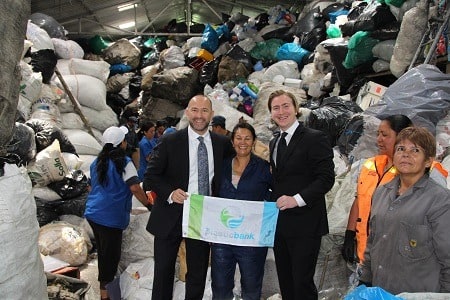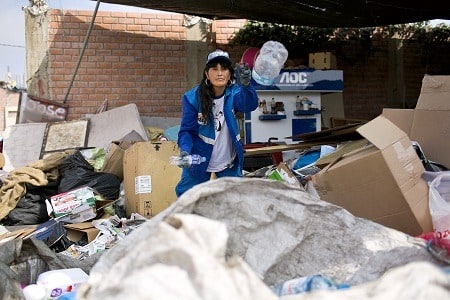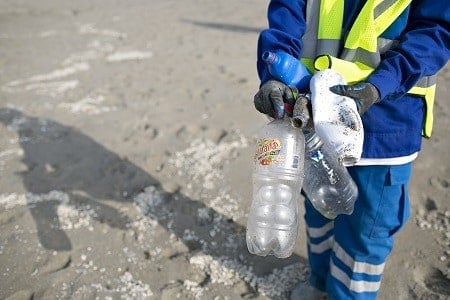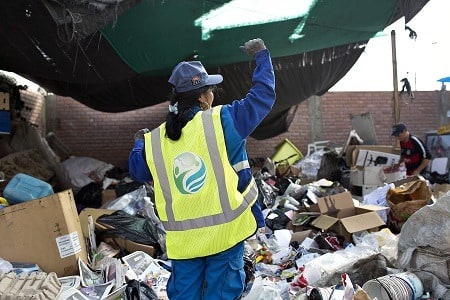Providing an opportunity for individuals to exchange their used plastics for monetary value, The Plastic Bank aims to keeping all plastic waste out of the environment. Monique Kassa, Communications Coordinator, talks with Waste Advantage Magazine about its goals and how it can help the waste and recycling industry.
What is The Plastic Bank and why was it developed? The Plastic Bank is providing an opportunity for individuals to return their plastic waste for cash value to reduce global poverty and plastic waste. It is setting up re-purposing/exchange centers for plastic waste in areas that have a high concentration of poverty and plastic pollution. Individuals who return plastic waste into The Plastic Bank collection centers receive above market fair trade cash value for their plastic. The Plastic Bank’s mandate is to provide a ladder of opportunity for the world’s poor to ascend from poverty by providing a reliable income and access to education, opportunities and 3D printing services. The exchange process for our recycled “Social Plastic®” improves the life of a disadvantaged person while cleaning our planet. The goal of The Plastic Bank is to lead the movement towards a worldwide demand for the use of Social Plastic® in everyday products. The higher the demand becomes, the greater the social impact towards helping the world’s poor. Much of the world’s ocean plastic starts on land in developing countries. The Plastic Bank has created a system to prevent ocean bound plastic waste from being dumped into oceans, rivers and waterways by making it too valuable to throw away.
David Katz, the Founder of The Plastic Bank, has always had the dream to bring hope to and liberate the minds of the world’s most disadvantaged and to rid the world of ocean plastic. His inspiration came from his travels, seeing beaches with more plastic than sand and people living in extreme poverty. David’s moment of clarity for the venture came in May 2013 at Singularity University in California, which focuses on educating, inspiring and empowering leaders to apply technologies to address humanity’s grand challenges. He realized that he needed to “Reveal Value in Plastic” in order to make it too valuable to throw away. David believes that using plastic as a currency not only creates value and opportunity to free people from merely surviving, but to give them the tools to thrive.
Explain what 3D printing is and how it can be applied to the waste/recycling industry. 3D printing is a process for making a physical object by using technology to lay down many successive thin layers of material, which have commonly been plastic. 3D printing enables products to be produced locally, while adding great value through customization. The Plastic Bank believes that 3D printing technology will have a tremendous role in helping to reduce both plastic pollution and poverty. In the developing world, gaining access to tools and necessities can be troublesome because supply chains are often fragmented. By revealing value in plastic through 3D printing, The Plastic Bank is making plastic too valuable to waste.
How is The Plastic Bank being used as a resource for the industry? The Plastic Bank provides a platform for individuals to return all of their plastics. This plastic is sorted, cleaned, shredded and re-pelletized. This new re-pelletized plastic is called Social Plastic®. We can pelletize any plastic for use in manufacturing to create new plastic items. LUSH cosmetics is using our Social Plastic® to manufacture their Sea Spray bottles.
What were the first plastics that were tested by the process? What were the challenges? The first type of plastic successfully printed was high-density polyethylene (HDPE). Much testing and research went into the 3D printing technology design to understand the required temperatures and settings to use HDPE in the extruder to create 3D printing filament.
What kind of plastic (recycled, new, dirty, clean, etc.) does the organization take to process? The Plastic Bank takes all plastics and sort at the center before recycling. There are partnerships in place to recycle all forms of plastic.
What is the ultimate goal? The Plastic Bank’s ultimate goal is to provide an opportunity for the world’s disadvantaged to become resource entrepreneurs and to view plastic waste as too valuable to throw away. With the success of our first location in Peru, we plan to have Plastic Bank collection centers all over the world, creating a business solution to poverty and plastic waste.
For more information, visit Plastic Bank on Twitter at @PlasticBank, Facebook at www.facebook.com/PlasticBank or on their Web site at www.PlasticBank.org.
Sidebar
“I believe 3D printing will dramatically change the entire logistics chain of manufacturing for select products. For example, the system we are developing would allow someone to collect a bag full of discarded plastic bottles and bring it to the very place that those bottles are turned into 3D printing filament and 3D printed. In this scenario the entire logistics chain of mining raw materials, creating plastic, delivering to a manufacturing facility and shipping to a store is completely removed. You would bring in your plastic and simply walk away with the finished product.
Social Plastic® is the recycled plastic collected through The Plastic Bank. It helps to improve the life of a disadvantaged person while cleaning the planet at the same time. It’s common practice in many of the areas we target for plastic waste to get dumped into the ocean bound rivers and water ways. One of the true missions of Social Plastic® is to provide a global incentive program to make plastic waste too valuable to be waste, and too valuable to ever end up in the ocean. Corporations can use our Social Plastic® for their manufacturing instead of using new virgin plastic which can also help reduce the amount of new plastic that gets produced each year.
Industry standards differ in each country. For example, it’s common for plastic products in developing countries to have no visible recycling symbol/number or even the wrong recycling symbol/numbers. Globally we are seeing a strong trend towards the use of one single type of plastic (as compared to items with multiple plastic types or mutant blends of plastic) that can easily be recycled such as PET and HDPE. We are also seeing a trend of the reduction and/or elimination of PVC which is much more difficult to safely recycle. A starting point for minimum standards really should be that all plastics are required to be labeled with the appropriate symbol in addition to the easiest to recycle plastic type being used at all times. The sooner this is done with out exception the sooner the global recycling rates can climb.”
—Shaun Frankson, Co-Founder, The Plastic Bank




Photos courtesy of The Plastic Bank.
